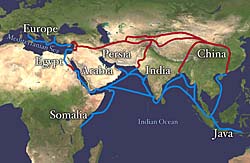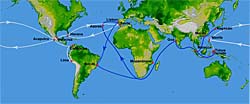
Unit 2: How Trade and Travel Changed the World
Lesson E: Rise of Early Europe
Activity 4: Larger Empires
Directions: Before you learn about the smaller states to emerge in Europe, read more about their differences with the Middle East and Asia below.
Larger empires, such as the Ottoman Empire in the Middle East, the Ming Dynasty in China, and the Delhi Sultanate in India, were known for their cultural achievements, government organization, and commerce.
Although historians have called them land-based empires, this does not mean that they did not participate in trade over water—only that they used sea travel less than the sea-based empires to later emerge in Europe. They were administered by Muslim or Confucian-style political beliefs. They were often tolerant of foreign cultures. They were also known for their use of long-distance trade to buy and sell goods. Scholars contributed important technological advances in science and mathematics. Finally, they were also dynastic, with their rulers being born into royal families.
As the feudal system declined in Europe, monarchs withdrew their financial and political ties to nobles and lords. The kingdoms of England and France, those of the Iberian Peninsula including Portugal and Spain, and Italian city-states all strengthened their control over land and wealth. They were ruled by a succession of kings and queens in the same family, and ruled over mainly Christian kingdoms. One way they strengthened their rule was through war with their competing neighbors and religious wars known as the Crusades.
Trade increased as travel became safer, and these empires became known for their navigation and commerce along the coasts of Europe, Africa, Asia, and the Mediterranean Sea. The expansion of travel and trade in the seas and oceans around Europe (pictured to the right) allowed them access to the land-based trade that had been interrupted by their larger neighbors in the Middle East and North Africa. Technological innovation also thrived due to education systems in which scholars passed on knowledge in universities.
Written Activity - Notebook
In your notebook, answer the following questions.
- What were the major similarities between the larger empires of Asia and smaller states in Europe during the 15th century?
- What were the major differences between the larger empires of Asia and smaller states in Europe during the 15th century?
- How did these similarities and differences allow emerging European states to challenge the economic and political power of the larger empires such as the Ottoman?
Use the information you learned in this activity as you learn more about the economic and political challenges posed by the emerging European states in the next activity.
Page Notes:
[1] Source: This image from http://en.wikipedia.org/wiki/File:Silk_route.jpg is in the public domain.
[2] This image from http://en.wikipedia.org/wiki/File:16th_century_Portuguese_Spanish_trade_routes.png is in the public domain.




